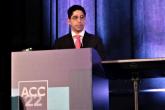Mitchel is a reporter for MDedge based in the Philadelphia area. He started with the company in 1992, when it was International Medical News Group (IMNG), and has since covered a range of medical specialties. Mitchel trained as a virologist at Roswell Park Memorial Institute in Buffalo, and then worked briefly as a researcher at Boston Children's Hospital before pivoting to journalism as a AAAS Mass Media Fellow in 1980. His first reporting job was with Science Digest magazine, and from the mid-1980s to early-1990s he was a reporter with Medical World News. @mitchelzoler
News

Sacubitril/valsartan shows cognitive safety in heart failure: PERSPECTIVE
- Author:
- Mitchel L. Zoler, PhD
Patients with heart failure on sacubitril/valsartan had no signal of cognitive decline, compared with controls in PERSPECTIVE, a prospective,...
News
Obesity drug shortage triggers frustrations, workarounds
- Author:
- Mitchel L. Zoler, PhD
A plant failure soon after the launch of semaglutide ... led to a U.S. shortage, a formal halt to new drug starts, and some creative workarounds...
News
Medicare advantage tied to less use of pricey diabetes drugs
- Author:
- Mitchel L. Zoler, PhD
“We worry that the cost-containment challenges [associated with MA plans] may be limiting use of these newer treatments.”
News
Bevacizumab first matches aflibercept for diabetic macular edema
- Author:
- Mitchel L. Zoler, PhD
Results from a randomized trial showed that step therapy for diabetic macular edema with lower-priced bevacizumab followed by pricier aflibercept...
News
Experts elevate new drugs for diabetic kidney disease
- Author:
- Mitchel L. Zoler, PhD
A consensus statement from the ADA and KDIGO recommends more aggressive combined use of several newer, and costly, drug classes to slow...
News

SGLT2 inhibitors cut AFib risk in real-word analysis
- Author:
- Mitchel L. Zoler, PhD
Observational data add to a growing link between SGLT2 inhibitor treatment and atrial fibrillation prevention in people with type 2 diabetes.
News

Antidiabetes drug costs keep patients away
- Author:
- Mitchel L. Zoler, PhD
Patients with diabetes and high med co-pays had worse fill rates, but even with low copays uptake of effective but expensive antidiabetes drugs...
News

Tirzepatide powers ‘unprecedented’ weight loss in SURMOUNT-1
- Author:
- Mitchel L. Zoler, PhD
The twincretin tirzepatide produced jaw-dropping levels of weight loss in people with obesity and no diabetes compared with placebo in the...
News
ADA prioritizes heart failure in patients with diabetes
- Author:
- Mitchel L. Zoler, PhD
Patients with diabetes should have annual screening for biomarkers of early-stage heart failure, and treatment should prioritize an SGLT2...
News
Newly approved tirzepatide’s retail price announced
- Author:
- Mitchel L. Zoler, PhD
The recently approved twincretin will carry a U.S. retail price similar to one of its main competitors, semaglutide, but patient discounts will be...
News

Tirzepatide (Mounjaro) approved for type 2 diabetes
- Author:
- Mitchel L. Zoler, PhD
Endocrinologists voice enthusiasm for the first approved agent for patients with type 2 diabetes that is a dual incretin agonist, but they also...
News

Combo of SGLT2 inhibitor + GLP-1 RA boosts diabetes survival
- Author:
- Mitchel L. Zoler, PhD
Survival of patients with type 2 diabetes and CVD rose by 80% when they received both an SGLT2 inhibitor and GLP-1 RA, compared with either class...
News

Empagliflozin rapidly improves acute heart failure symptoms in hospitalized patients
- Author:
- Mitchel L. Zoler, PhD
Empagliflozin showed symptomatic benefits in patients hospitalized for acute heart failure after 2 weeks in a secondary analysis from the EMPULSE...
News

Flu vaccines cut seasonal death in heart failure patients
- Author:
- Mitchel L. Zoler, PhD
Annual influenza vaccines significantly cut death during serial flu seasons in patients with heart failure in...
News

Mavacamten controlled hypertrophic cardiomyopathy for over 1 year
- Author:
- Mitchel L. Zoler, PhD
Open-label mavacamten in patients with symptomatic obstructive hypertrophic cardiomyopathy for a median 62 weeks...
